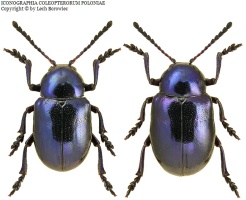
Русские, остановите эту войну! Спасите Свободную Украину!
Russians, stop this war! Save Free Ukraine!
Biodiversity Map
Taxa

Chrysochus — subordinate taxa:
Taxon count: 4
-
Chrysochus asclepiadeus asclepiadeusSet as tree root ↑
Show taxon data → ⚑
 [86] → Show taxon data
[86] → Show taxon data -
Chrysochus chinensisSet as tree root ↑
Show taxon data → [3] → Show taxon data -
Chrysochus goniostomaSet as tree root ↑
Show taxon data → [2] → Show taxon data -
Chrysochus yunnanusSet as tree root ↑
Show taxon data → [2] → Show taxon data
-
Arthropodaphylum
Click to switch
to select orders
and filters > -
Hexapodasubphylum
Click to switch
to select orders
and filters > -
Insectaclass
Click to switch
to select orders
and filters > -
Coleopteraorder
Click to set
as the main taxon
and as a base
← of the left panel > -
Polyphagasuborder
Click to set
as the main taxon
and as a base
← of the left panel > -
Cucujiformiaseries
Click to set
as the main taxon
and as a base
← of the left panel > -
Chrysomeloideasuperfamily
Click to set
as the main taxon
and as a base
← of the left panel > -
Chrysomelidaefamily
Click to set
as the main taxon
and as a base
← of the left panel > -
Eumolpinaesubfamily
Click to set
as the main taxon
and as a base
← of the left panel > -
Eumolpinitribe
Click to set
as the main taxon
and as a base
← of the left panel > -
Chrysochusgenus
Click to set
as the main taxon
and as a base
← of the left panel > -
Chrysochus asclepiadeusspecies
Click to set
as the main taxon
and as a base
← of the left panel >
PL
YES
name status: valid name
BioMap ID: 1026442
taxon code: 4360
taxonomy checked: YES
Polish Red List: NT
Data on distribution in Poland

Statistics
- Records: 86
- Publications: 16
- Collections: 3
- Publication authors: 14
- Illustrations (iconography): 1
- Photos (specimen/observation): 1
Taxon description
Gatunek rozmieszczony w południowej i środkowej części Europy, Azji Mniejszej, Azji Środkowej, Mongolii i w północnych Chinach. W Polsce chrząszcz mało znany, notowany z nielicznych, rozproszonych stanowisk w pięciu krainach, ale niektóre dane o jego występowaniu opierają się na znaleziskach w zeszłym stuleciu lub na początku XX wieku, dlatego też wymagają potwierdzenia nowymi materiałami. Omyłkowa jest wzmianka (Warchałowski 1971) jakoby gatunek ten był łowiony pod Warszawą, prawdopodobnie chodzi tu o stanowisko «Ruda Gawrychowska» na Pojezierzu Mazurskim. Chrząszcz występuje na słonecznych stanowiskach na niżu i w niższych położeniach górskich. Poławiany od czerwca do września. Żyje na ciemiężyku białokwiatowym — Vincetoxicum officinale Mnch., na którego korzeniach żeruje larwa.
Illustrations
... browse
 Chrysochus
Chrysochusasclepiadeus
asclepiadeus
Photos
... browse
 Chrysochus
Chrysochusasclepiadeus
asclepiadeus
External data sources
- Ostatnie rekordy
-
1021078
 ×
× Chrysomelidae: Chrysochus asclepiadeus asclepiadeus, [brak danych], coll. MiIZ PAN: Tenenbaum Sz.
Chrysomelidae: Chrysochus asclepiadeus asclepiadeus, [brak danych], coll. MiIZ PAN: Tenenbaum Sz. -
1021077
 ×
× Chrysomelidae: Chrysochus asclepiadeus asclepiadeus, coll. MiIZ PAN: Tenenbaum Sz.
Chrysomelidae: Chrysochus asclepiadeus asclepiadeus, coll. MiIZ PAN: Tenenbaum Sz. -
1021076
 ×
× Chrysomelidae: Chrysochus asclepiadeus asclepiadeus, Dźwinogród, 1937, coll. MiIZ PAN: Tenenbaum Sz.
Chrysomelidae: Chrysochus asclepiadeus asclepiadeus, Dźwinogród, 1937, coll. MiIZ PAN: Tenenbaum Sz. -
1021075
 ×
× Chrysomelidae: Chrysochus asclepiadeus asclepiadeus, coll. MiIZ PAN: Tenenbaum Sz.
Chrysomelidae: Chrysochus asclepiadeus asclepiadeus, coll. MiIZ PAN: Tenenbaum Sz. -
1021074
 ×
× Chrysomelidae: Chrysochus asclepiadeus asclepiadeus, coll. MiIZ PAN: Tenenbaum Sz.
Chrysomelidae: Chrysochus asclepiadeus asclepiadeus, coll. MiIZ PAN: Tenenbaum Sz. -
1021073
 ×
× Chrysomelidae: Chrysochus asclepiadeus asclepiadeus, coll. MiIZ PAN: Tenenbaum Sz.
Chrysomelidae: Chrysochus asclepiadeus asclepiadeus, coll. MiIZ PAN: Tenenbaum Sz. -
1021072
 ×
× Chrysomelidae: Chrysochus asclepiadeus asclepiadeus, Kołodróbka, 1936, coll. MiIZ PAN: Tenenbaum Sz.
Chrysomelidae: Chrysochus asclepiadeus asclepiadeus, Kołodróbka, 1936, coll. MiIZ PAN: Tenenbaum Sz. -
1021071
 ×
× Chrysomelidae: Chrysochus asclepiadeus asclepiadeus, Kołodróbka, 1933, coll. MiIZ PAN: Tenenbaum Sz.
Chrysomelidae: Chrysochus asclepiadeus asclepiadeus, Kołodróbka, 1933, coll. MiIZ PAN: Tenenbaum Sz. -
1021070
 ×
× Chrysomelidae: Chrysochus asclepiadeus asclepiadeus, Kołodróbka, 1933, coll. MiIZ PAN: Tenenbaum Sz.
Chrysomelidae: Chrysochus asclepiadeus asclepiadeus, Kołodróbka, 1933, coll. MiIZ PAN: Tenenbaum Sz. -
1021069
 ×
× Chrysomelidae: Chrysochus asclepiadeus asclepiadeus, coll. MiIZ PAN: Tenenbaum Sz.
Chrysomelidae: Chrysochus asclepiadeus asclepiadeus, coll. MiIZ PAN: Tenenbaum Sz. - ... more
- Powiązane publikacje
-
Burakowski B., Mroczkowski M., Stefańska J. 1990b. Chrząszcze – Coleoptera. Stonkowate – Chrysomelidae, część 1. Katalog Fauny Polski, XXIII, 16, Warszawa.
 Show records
Show records -
Warchałowski A. 1971. Część XIX. Chrząszcze – Coleoptera. Stonkowate – Chrysomelidae. Część ogólna i podrodziny Donaciinae, Orsodacninae, Criocerinae, Clytrinae, Cryptocephalinae, Lamprosomatinae i Eumolpinae. Klucze do Oznaczania Owadów Polski, 72, 94a, Warszawa.
 full text
full text Show records
Show records -
Węgrzecki M. 1963. Materiały do poznania rodziny Chrysomelidae (Coleoptera). Fragm. Faun., 11:1-19.
 Show records
Show records -
Szymczakowski W. 1960. Materiały do poznania kserotermofilnej fauny chrząszczy Wyżyny Małopolskiej. Pol. Pismo Ent., 30(1):173-242.
 full text
full text Show records
Show records -
Kuntze R. 1931c. Vergleichende Beobachtungen und Betrachtungen über die xerotherme Fauna in Podolien, Brandenburg, Österreich und der Schweiz. Z. Morphol. Ökol., 21:629-690.
 Show records
Show records - ... more




